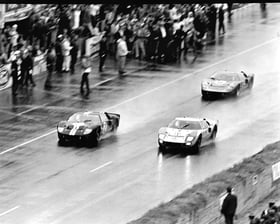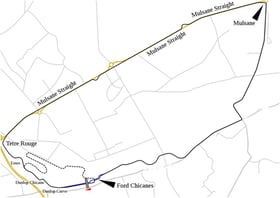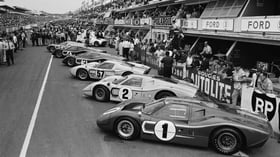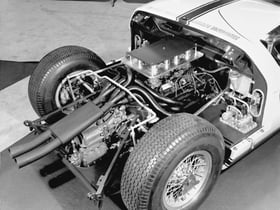In 2019, the movie Ford vs. Ferarri (starring Matt Damon, Christian Bale, and Catriona Balfe) relaunched the tale of the iconic win by Ford over Ferrari on the Le Man racetrack in 1966 back into the minds of racing fans. The equally impressive feat is how Ford came back to defeat Ferrari yet again in 2016, fifty years after the original win. How did they do it, and why does it matter? Here's a rundown of the significance of the Le Mans race to the automotive industry and the tenacity of the Ford development teams to pull off stunning wins against the odds.
What Is the Le Mans Race?
 The Le Mans race, officially known as the "24 Hours of Le Mans," is one of the most prestigious and iconic endurance car races in the world. The first ever race took place back in 1923 near the town of Le Mans, France, and has been held there annually ever since—except for the years during World War II. The race lasts for a grueling 24 hours and requires a team of drivers to take turns driving the cars continuously, testing both the endurance of the drivers and the vehicles.
The Le Mans race, officially known as the "24 Hours of Le Mans," is one of the most prestigious and iconic endurance car races in the world. The first ever race took place back in 1923 near the town of Le Mans, France, and has been held there annually ever since—except for the years during World War II. The race lasts for a grueling 24 hours and requires a team of drivers to take turns driving the cars continuously, testing both the endurance of the drivers and the vehicles.
Not only does the race test the endurance of the car and the drivers, it is a testing ground for industry advancement. The first competition was meant to encourage technical innovation in the automotive industry and continues to do so over 100 years later. New technology, such as the radial tire and the first hybrid engines, were tested first on the Le Mans race circuit.
The Route: Circuit de la Sarthe
 The Le Mans race is interesting as it consists of both public roads and a dedicated race track. The entire circuit de la Sarthe spans 13,626 km and has been modified over the decades to increase safety for the drivers while designing the route for speed and unrivaled racing action. With long sections of straight track, challenging corners, and high-speed sections, the course demands skill.
The Le Mans race is interesting as it consists of both public roads and a dedicated race track. The entire circuit de la Sarthe spans 13,626 km and has been modified over the decades to increase safety for the drivers while designing the route for speed and unrivaled racing action. With long sections of straight track, challenging corners, and high-speed sections, the course demands skill.
The Significance of Le Mans
The Le Mans race is not just a spectacular event to watch; it plays a significant role in the automotive industry's innovation. Because the event is 24 hours in length, racing teams must balance their speed with their vehicle's ability to run for 24 hours without mechanical failure.
These unique circumstances make Le Mans an excellent testing ground that pushes new designs to the limit. The race has been a platform for technological advancements since the beginning, and manufacturers continue to use the race to showcase their engineering prowess before the features make their way into production in road-ready vehicles for regular customers.
Ford vs. Ferrari: 1966
 The Le Mans race is usually dominated by cars built for speed and endurance, such as Porsche, Audi, and Ferrari. In the 1960s, the American car manufacturer Ford wanted in on the success. After a failed collaboration agreement with the Italian Ferrari automotive company, the Ford team was determined to win the legendary race with their own product. The first two years ('64 and '65) that Ford entered the race resulted in their cars failing to finish. This is why their 1966 sweep of first, second, and third was so surprising.
The Le Mans race is usually dominated by cars built for speed and endurance, such as Porsche, Audi, and Ferrari. In the 1960s, the American car manufacturer Ford wanted in on the success. After a failed collaboration agreement with the Italian Ferrari automotive company, the Ford team was determined to win the legendary race with their own product. The first two years ('64 and '65) that Ford entered the race resulted in their cars failing to finish. This is why their 1966 sweep of first, second, and third was so surprising.
Ford developed a specialized team that focused solely on designing a car that could win. They knew they needed a car that was lighter, faster, and could endure the twenty-four-hour race. The team built prototypes, tested them, and rebuilt them until they had a winning product that took the competition by surprise.
Ford vs. Ferrari: 2016
 Fast forward fifty years later to the 2016 Le Mans race, and Ford repeated their win with a new version of the same car, the GT 40. The road to winning the race five decades later didn't happen overnight. It was a plan that was several years in the making. According to Ford CEO Jim Farley, the development team worked on the engine first. They tested the engine in their Mustang models in various other races. Once satisfied they had an engine that could win, they focused on creating the shell.
Fast forward fifty years later to the 2016 Le Mans race, and Ford repeated their win with a new version of the same car, the GT 40. The road to winning the race five decades later didn't happen overnight. It was a plan that was several years in the making. According to Ford CEO Jim Farley, the development team worked on the engine first. They tested the engine in their Mustang models in various other races. Once satisfied they had an engine that could win, they focused on creating the shell.
While the Mustang is an iconic line of vehicles, the Ford team knew that it would need to be faster to enter Le Mans. The Ford team needed a car that excelled in aerodynamics. Repeated testing, assessing, and iterating led to the launch of a new Ford GT that would deliver the win of Le Mans on the 50th Anniversary of their first win.
The Takeaways of the Ford Wins at Le Mans
Winning the Le Mans race is a highly prestigious achievement and holds great significance in the world of motorsports, alongside races such as the Indianapolis 500 and the Monaco Grand Prix. But just because a car manufacturer wins a race, it doesn't translate to success in sales off the race track. Here are some of the main takeaways that have led to Ford's success on and off the circuit.
Think Big and Innovate
 Ford didn't allow the seemingly impossible task of beating Ferrari at their own game to stand in their way. They assembled a team of big thinkers and innovated a new model of racecar that achieved their product vision. Innovation is a large motivator across the board in automotive races like Le Mans.
Ford didn't allow the seemingly impossible task of beating Ferrari at their own game to stand in their way. They assembled a team of big thinkers and innovated a new model of racecar that achieved their product vision. Innovation is a large motivator across the board in automotive races like Le Mans.
Testing the MVP
Long before the race in France, Ford tested their parts on other circuits, starting with the motor and then with the body of the car. Once they had a winning model to endure other races, they knew they were ready to enter Le Mans. The Ford team didn't wait until they thought each component was working before testing; they put the engine in several different models to see how it would function before perfecting the shell.
Encourage Collaboration
The original 1966 win would not have happened without a highly collaborative team with an aligned vision to win the Le Mans competition. While not every product developed requires the same resources to create as the Ford GT model did, there are lessons to be learned from the value of cross-functionality and a clear product vision. When everyone working on the product is aligned with the goal, better products are often the result.
Using the Minimum Viable Product Approach
Many companies use the minimum viable product approach to perfect and launch leading products in their industries. It is not a strategy reserved for automotive manufacturing. Product teams that utilize their product roadmaps, collaborate with their teams, and follow their product strategy goals are more likely to see results, no matter their industry.
Book your free demo with our team to see first-hand how Gocious product roadmap software can support your product management teams.


